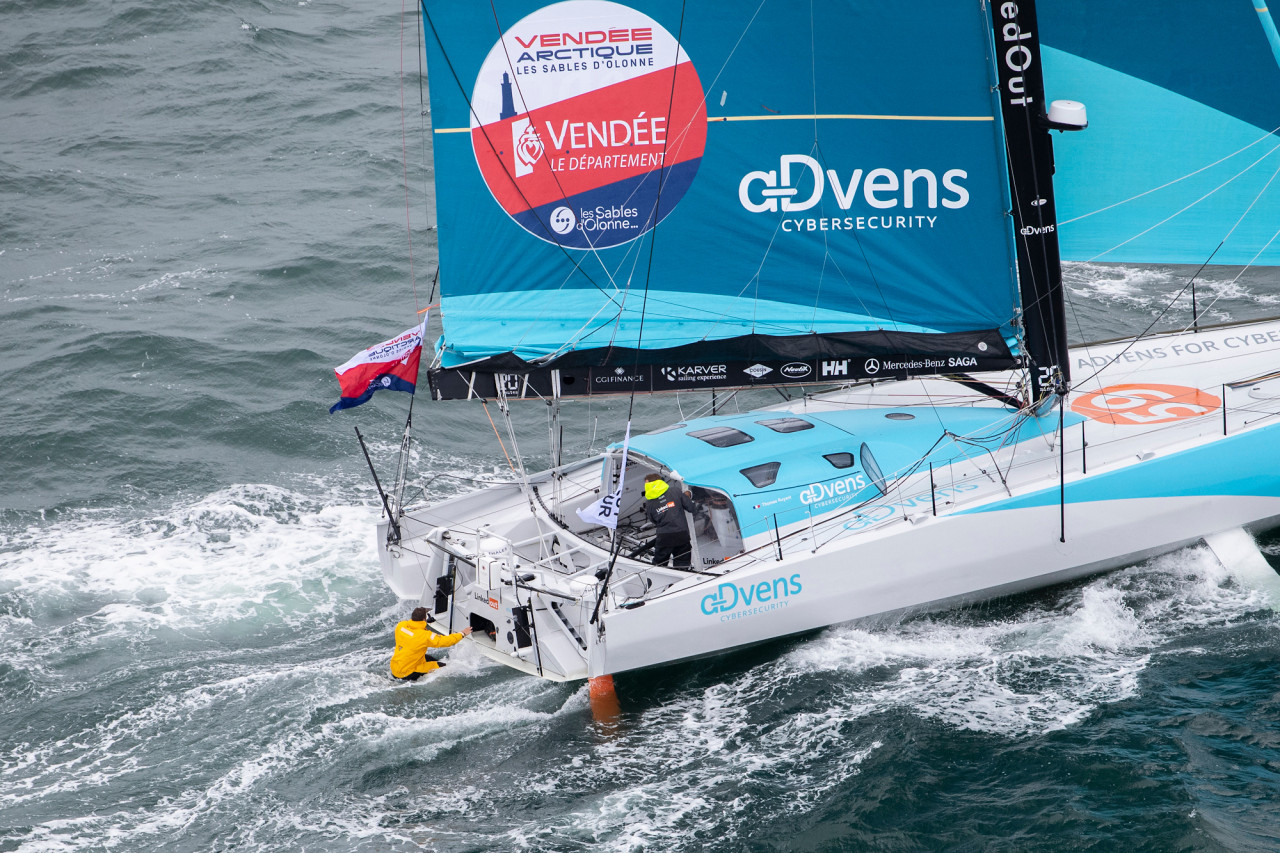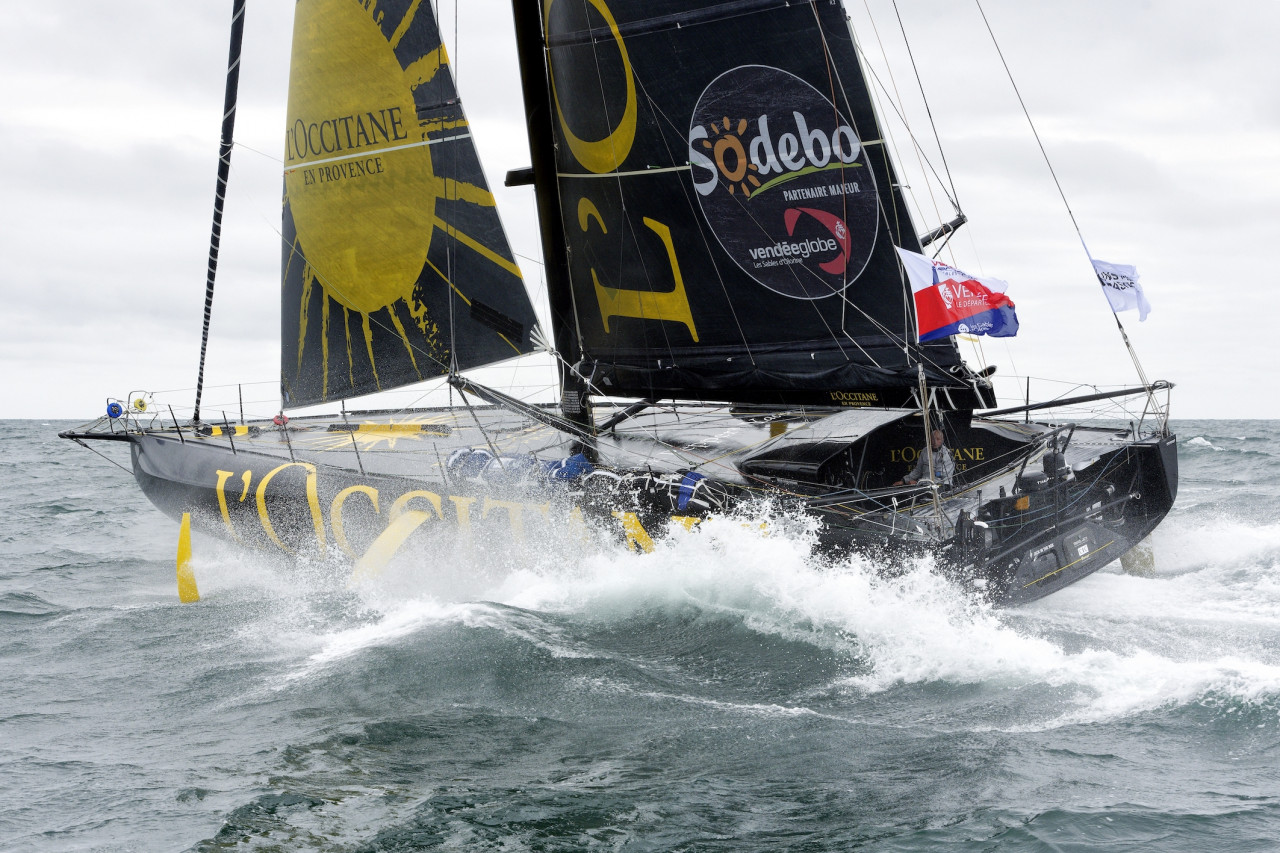Ruyant leads the charge as the boats head across the mouth of the English Channel

Thomas Ruyant on the Guillaume Verdier-designed LinkedOut is this morning leading the IMOCA fleet as the skippers in the Vendée-Arctique-Les Sables d’Olonne Race head upwind off the western tip of Brittany.
Ruyant is making good progress on his new foiler after a rough first night that has seen the fleet sail up along the Brittany coast and now along the western edge of the Traffic Separation Scheme off Ushant. He is setting a good pace, making up to 14 knots of boatspeed in 17-20 knots of westerly wind and building seas as he continues on a northeasterly heading towards the southwest tip of Ireland.
The leader had an advantage of just under three nautical miles over Kévin Escoffier who is on his first major solo race in the class aboard the 2010-vintage but much-modified VPLP/Verdier designed PRB. Escoffier is already showing all the experience that is going to make him a serious podium contender in his first Vendée Globe later this year.
Just a couple of miles behind him is Jérémie Beyou on Charal who has a four-mile cushion over Charlie Dalin on Apivia. Then there is a gap of a further four miles to Isabelle Joschke on MACSF who is just ahead of Boris Herrmann on SeaExplorer-YC de Monaco in sixth place with his new foils.
The skippers have had a rough opening to this 3,600-mile race that takes them up to Iceland and then down to the Azores. Ruyant, a former winner of the Mini Transat 6.50 and the Route du Rhum in Class 40, admitted it is taking him a bit of time to get used to the shock of being at sea in the most powerful offshore monohulls in world sailing. “I’m still getting my bearings on board,” said the Lorient-based skipper on the blue and white foiler built at Persico Marine in Italy last year. “I haven’t slept much or eaten too much since the start, but my appetite is beginning to come on, so I’m going to be able to make myself a good breakfast this morning.”
“There is always a little time to adjust before I’m completely well aboard,” he added. “It’s not completely good for me yet, but it’s happening little by little and I’m starting to feel good in the race now.” Ruyant also admitted it has been a rough ride so far. “We’re still being shaken around a lot, but the problem with these boats is that we’re going to be shaken around all the time, I think!” he said.
Behind him Armel Tripon reflected on the spectacular start he produced on the brand new L’Occitane en Provence as he led the fleet to the first turning mark – the Institute Pasteur buoy. He said it was a way of saying thank-you to his team for all the work they had put in to get the new boat to the startline. “It was nice for the whole team,” he said, “a way of thanking them for their work and commitment, which enabled me to take the start yesterday.” Tripon added that since that early phase in the race he has dropped back – he is now in seventh place, 21 miles behind the leader – because he is still finding the optimum mode to sail his Sam Manuard-designed IMOCA.
 © François Van Malleghem / Imoca
© François Van Malleghem / Imoca
“There was a big sea and a lot of impacts,” he said. “You have to find the right balance to manoeuvre the boat and I’ve still got a lot of little things to tinker with, right and left. I’ve managed to get some sleep at the beginning of the night, feed myself and change my clothes because I was soaking wet. They’re very wet boats.”
In fifteenth place, the Concarneau skipper Maxime Sorel aboard V&B-Mayenne – one of six non-foiling boats in the race – has chosen a course slightly further offshore than most of the fleet. He said he had had a good first night and the seas were not as rough as he had imagined.“I slept and ate well and I’m going to attack the second day in better shape than I thought I would be,” he said. “I’m really in training mode for the Vendée Globe in this race, so my aim is to test as many things as possible on the boat.”
So far one skipper has had to drop out. Sébastien Simon reported a broken starboard foil aboard Arkéa-Paprec early yesterday evening and was forced to divert to Port-La-Forêt where his boat remains this morning as his team work to discover exactly what caused the failure.
Up ahead of all the skippers lies a complex and changeable weather picture as the fleet continues on its north-easterly heading towards Iceland. As is often the case the sailors who manage the transitions best will make biggest gains. It’s going to be a fascinating week ahead.
Ed Gorman
Teams info
After a stunning 2025 season Sam Goodchild is the IMOCA Globe Series Champion for the second time
After a long season at the top of the IMOCA fleet that featured three race wins, Great Britain’s Sam Goodchild is for the second time in three years the IMOCA Globe Series Champion.
•••Quel rôle peut jouer la course au large dans la transformation du transport international ? Avec Pie…
Pour ce 10ᵉ épisode de Transitions, enregistré au Havre lors du départ de la Transat Café L'Or, nous recevons Jeremy Pochman, PDG de 11th Hour Racing, et Pierre-Antoine Morvan, responsable du pôle course au large et supe…
•••